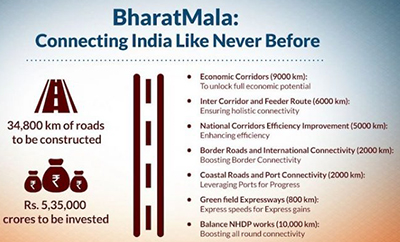Relevance: GS-3: Infrastructure: Energy, Ports, Roads, Airports, Railways;
Key Phrases: To revamp the logistics system, umbrella project, 34,800 Km NHs, 6-year delay, connectivity to North-Eastern Region, Act East, Rs 5.35 L Cr, National Corridor Efficiency Improvement;
Context
- Bharatmala Project, launched in July 2015, aimed to revamp the
logistics system by creating transportation infrastructure.
- It aimed to create 24,800 Km NHs (National Highways) and a residual of 10,000 Km of highways.
- The project was aimed to be completed in 2022, but due to the pandemic and exorbitant increase in land acquisition costs, the project is slated to be delayed by 6 years.
Key Highlights
What is the Bharatmala Project?
- It is an umbrella project to create 83,677 km of highways in 5 years.
- It is being undertaken by MoRTH (Ministry of Road Transport and Highways).
- The 1st phase of the project aimed to create 34,800 km at the cost of Rs 5.35 lakh Crores.
What are its components?
- The project has 7 components
- Economic Corridors
- 9000 km of roads to be constructed to connect important cities which are engines of the Indian Economy.
- Feeder Route or Inter Corridor
- 6000 km of roads to be constructed in this category.
- National Corridor Efficiency Improvement
- 5000 km of roads for improving the connection between the roads.
- Border Road and International Connectivity
- 2000 km of roads to connect remote border towns and the cities.
- Port Connectivity and Coastal Road
- 2000 km to connect port cities.
- Green Field Expressway
- Construction and development of Green Field Expressway for better management of traffic and freight.
- Balance NHDP Works
- Construction and Maintenance of about 10,000kms new roads.
- Economic Corridors
Funding of the project
- Planning
- In terms of funding, the project initially envisaged 40% each
from internal and extra-budgetary resources, and the balance of 20%
from gross budgetary support, including toll collections and private
sector investment.
- Fuel Cess collected from the petrol pumps also served as an important source of funding for this project.
- In terms of funding, the project initially envisaged 40% each
from internal and extra-budgetary resources, and the balance of 20%
from gross budgetary support, including toll collections and private
sector investment.
- Current Reality
- The government has increased budgetary allocation to NHAI by 106% to Rs 1.34 L Cr while reducing its incremental borrowing to nil for FY 2023.
- Despite the cut in Fuel Cess, the allocation to the road ministry is predicted to be constant.
Benefits/ Advantages
- Improving Logistics efficiency
- Logistics costs in India are at a higher proportion [13-14% in 2015] of the total value of goods as compared to developed nations [7 – 8%].
- Also, this value has increased in the last few years.
- In India, road freight cost per tonne per sq km is 1.9 (which is double that of the US).
- Augmenting Unity in Diversity
- Movement of people across different regions for commercial purposes also increases the cultural affinity towards each other.
- Increased connectivity to North-Eastern Region
- It will aid in the socio-economic development of the northeast which has huge developmental potential.
- The Northeast Economic Corridor will connect state capitals and key towns.
- Multimodal terminals will be created at 7 waterway terminals on
River Brahmaputra.
- These are: Dhubri, Silghat, Biswanath Ghat, Neamati, Dibrugarh, Sengajan and Oriyamgh.
- Connecting our neighbours to reap the Connectivity dividend from
a stronger socio-economic and cultural relationship
- Connectivity with Bangladesh will reduce geographic isolation from the Northeast.
- Integrating and supporting BBIN (Bangladesh-Bhutan-India-Nepal) and IMT (India-Myanmar-Thailand) initiatives in line with the vision of ‘Act East’.
- Usage of technology and scientific planning will transform the way
construction projects are delivered in India.
- An efficient mode of construction will aid in the transformation of the Indian Economy from a developing one to a developed one.
Challenges/ Concerns
- Exponential Increase in land acquisition cost
- As per ICRA, the cost has risen by a full 99% to ₹10.63 lakh crore and is likely to rise by another 15-20%, given the massive spike in input cost and land prices.
- Delays in awarding of project
- During the past 7 years, only 60% of the 34,800 km of the project has been awarded. [till Dec 2021]
- Delays in project completion
- Till March 2022, 23% of the 34,800 km have seen completion.
- Chances of delays in the future
- As observed in 2019, due to the election the awarding of the projects got delayed.
- Similar delays could be expected in FY 2024 pushing the awarding of projects to FY 2025.
Way Forward
- For Funding
- NHAI should be allowed to borrow from the market. (MoRTH is considering this move to expedite the execution of the project)
- Asset Monetization Plans become important in ensuring a continuous supply of funds.
- Awarding of the projects should be fast-paced in order to ensure timely completion of the project.
- An audit by NITI aayog and a roadmap for the project must be released to ensure that no hindrance (natural - like the Pandemic or Man-made - Increased Land cost) derails the project timeline.
Conclusion
- As per Economic Survey 2021-22, India has constructed roads at a record speed of 36.5 km per day. The same should be extended for projects related to Bharatmala as well so that holistic development can reach every part of the country, turning the $5 Tn dream into a reality.
Source: The Hindu BL
Mains Question:
Q. What is the Bharatmala Project? Explain the reasons behind the delay of the projects. How can this be remedied?








